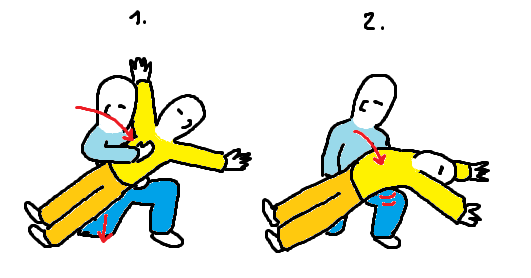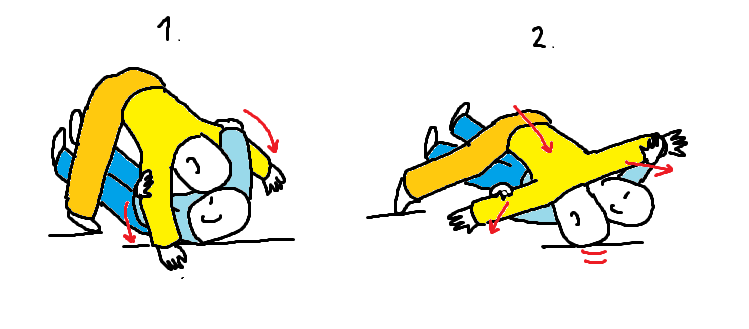
Warning! The techniques described below can cause serious injury or death and are shown for historical purposes only!
If today's martial arts are typical by something, it is their extremely low level of understanding of their classical techniques and tactics. Generally, modern martial arts operate as a cargo-cult regarding their history - training 'bizarre' historic techniques they do not understand; and expecting them to somehow magically improve their fighting skills.
However, training without understanding leads nowhere; in the best case, it won't interfere with skills obtained by other training methods. (For example, modern karate kata training has no effect on sparring proficiency). That is in the best case - in the worst cases, it has detrimental effect on the actual fighting skills.
In this article, I want to give an example of 'bizarre' historical techniques and its extremely practical and lethal meaning; that however flies high over the head of its modern practitioners.
-
The techniques are from Koshiki-no-kata of Judo; an old form adapted by Jigoro Kano to preserve the old battlefield jujutsu techniques. I will not analyze the kata as a whole; only the two throws used at the beginning; to give you a general idea.
You will see how two impotent-looking techniques are in fact powerful weapons.
This is a video of Koshiki-no-kata:
https://www.youtube.com/watch?v=3LUUrewuIDk
Let us focus on two techniques:
1.Tai (0:58)
https://youtu.be/3LUUrewuIDk?t=58
In this technique, the fighter gets behind the opponent; then quickly kneels down on his right knee, pulling the opponent down onto his back with his arms.
After taking the opponent down, the fighter places his left knee up to the side theatrically.
2. Yume-no-uchi (1:31)
https://youtu.be/3LUUrewuIDk?t=91
In this technique, the fighter falls on his back, pulling the opponent down and over himself into a front roll.
As the opponent rolls over, the technique is finished by the fighter lying on the ground and spreading his arms and legs like a starfish.
Now, taken verbatim (as they are done), the techniques are silly. There certainly are more efficient ways to take the opponent down; for example, sukui nage in the first, and tomoe nage in the second case.
So why did the creator of Koshiki-no-kata opt for the above silly alternatives? And why are there the theatrical gestures after throwing the opponent?
For modern practitioner, the answers are simple: "It is an old kata." - As if people of old were stupid! "It was to be done in armor" - As if that changed something! "It is a ritual" - Again, as if people of old had time for useless, bizarre rituals in their combat training!
The real reason is that modern people simply don't understand the simple and lethal intent behind Koshiki-no-kata.
Let me explain.
First, Koshiki-no-kata techniques were indeed created for use on the battlefield. But that does mean they have to be more effective than the sport techniques, not less! After applying the technique of Koshiki no kata, the opponent should not be able to get up - ideally, he would be dead; or at least, be no longer a threat.
That means that the target of the technique must be opponent's spine. Only by targeting opponent's spine you can put him out of combat reliably. The technique I chose target lumbar and cervical spine, respectively.
Old spinebreakers
In Tai, you indeed get down on your right knee to pull the opponent down with you; but in real use, you put your left knee up to the side before you make him fall. The effect is that he falls down with his back across your left knee, fracturing his lumbar spine.

In training, this gesture is done after opponent's fall to protect your training partner; but to remind you you should do it when executing the technique for real.
In Yume-no-uchi, you pull the opponent down with you as you lie down; but at the same time, you spreads your arms, and thus his arms.
This makes him plunge headfirst into the ground above your left shoulder, damaging his cervical spine; unlike in the training version, where he is allowed to roll out of the technique.

Again, in training, the arm-spread is done after the throw to protect the uke; but to remind you you should do it in real use.
This is the reason why the 'bizarre' techniques are used in Koshiki-no-kata instead of, say, tomoe nage: Because these technique are more effective on the battlefield, not less; unlike tomoe nage or sukui nage, they kill or cripple the opponent outright.
As you see, in Koshiki-no-kata, what appears to be bizarre and impractical throws to modern understanding are in fact very simple, practical and lethal battlefield spinebreakers.
It is very often so with the old battlefield techniques; the problem is very seldom their ineffectiveness. What is the problem is modern lack of understanding.
It is also interesting to note that even judo has spine breakers - albeit no one knows about this, as they are hidden in an old, 'ritual and useless' kata.
What is interesting about Koshiki-no-kata is that it teaches spine breakers safely - you do not actually break your training partner's spine during training, yet, you train what is it like to throw him.
Excursus
There is, actually, a lot more to Koshiki-no-kata; the above is just scratching the surface. However, your own teachers will never teach you that, because they do not know it - I know that they do not know, because I see how they move - meaning, the black and red-and-white belted notables in the videos.
The archetypes they use to move tell the story - the story of ignorance. It is sad that the real teachings of Koshiki-no-kata seem to be completely lost in judo; perhaps later I will publish a book about this kata.
Update:
Let me give you an example, a bit funny one:
In one technique of Koshiki Omote (Shikoro-gaeshi), you spread your legs and fall on your butt, pulling opponent's head with you (5:25):
https://youtu.be/3LUUrewuIDk?t=324
Properly in Koshiki, this takedown must be done using Iron groin skill of Bear archetype; as only this skill can protect your groin(testicles) from the impact with the ground, so the throw can be executed painlessly and safely.
Yet, if you look at all the high-ranked judoka doing the takedown, as they do not know Bear Iron groin, you see them simply fall down hard(Snake mechanics), hurting their own balls. And that is on a soft mat; imagine it being a hard surface.
(Sometimes they cheat, as this gentleman who purposefully twists sideways to avoid hitting his balls against the ground:
https://www.youtube.com/watch?v=kz80QMuQLGU
But that of course would not work for real.)
So what was originally a technique inventively utilizing advanced body mechanics (Iron groin skill of Bear archetype) is in today's judo just a stupid fall used to hurt your own balls...such is the result of ignorance.
This Web Page was Built with PageBreeze Free HTML Editor